
Kernite, also known as rasorite, is a hydrated sodium borate hydroxide mineral with formula Na
2B
4O
6(OH)
2·3H
2O. It is a colorless to white mineral crystallizing in the monoclinic crystal system typically occurring as prismatic to acicular crystals or granular masses. It is relatively soft with Mohs hardness of 2.5 to 3 and light with a specific gravity of 1.91. It exhibits perfect cleavage and a brittle fracture.

Sylvite, or sylvine, is potassium chloride (KCl) in natural mineral form. It forms crystals in the isometric system very similar to normal rock salt, halite (NaCl). The two are, in fact, isomorphous. Sylvite is colorless to white with shades of yellow and red due to inclusions. It has a Mohs hardness of 2.5 and a specific gravity of 1.99. It has a refractive index of 1.4903. Sylvite has a salty taste with a distinct bitterness.

Thermonatrite is a naturally occurring evaporite mineral form of sodium carbonate, Na2CO3·H2O.

Thénardite is an anhydrous sodium sulfate mineral, Na2SO4 which occurs in arid evaporite environments, specifically lakes and playas. It also occurs in dry caves and old mine workings as an efflorescence and as a crusty sublimate deposit around fumaroles. It occurs in volcanic caves on Mount Etna, Italy. It was first described in 1825 for an occurrence in the Espartinas Saltworks, Ciempozuelos, Madrid, Spain and was named for the French chemist, Louis Jacques Thénard (1777–1826).

Sellaite is a magnesium fluoride mineral with the formula MgF2. It crystallizes in the tetragonal crystal system, typically as clear to white vitreous prisms. It may be fibrous and occur as radiating aggregates. It has a Mohs hardness of 5 to 6 and a specific gravity of 2.97 to 3.15. Refractive index values are nω = 1.378 and nε = 1.390.

Diadochite is a phospho-sulfate mineral. It is a secondary mineral formed by the weathering and hydration of other minerals. Its formula is Fe2(PO4)(SO4)OH·5H2O. Well crystallized forms are referred to as destinezite, which has been given official recognition by the International Mineralogical Association with diadochite being the poorly formed to amorphous variety.

Polyhalite is an evaporite mineral, a hydrated sulfate of potassium, calcium and magnesium with formula: K2Ca2Mg(SO4)4·2H2O. Polyhalite crystallizes in the triclinic system, although crystals are very rare. The normal habit is massive to fibrous. It is typically colorless, white to gray, although it may be brick red due to iron oxide inclusions. It has a Mohs hardness of 3.5 and a specific gravity of 2.8.

Brushite is a phosphate mineral with the chemical formula CaHPO4·2H2O. Crystals of the pure compound belong to the monoclinic space group C2/c and are colorless. It is the phosphate analogue of the arsenate pharmacolite.

Hanksite is a sulfate mineral, distinguished as one of only a handful that contain both carbonate and sulfate ion groups. It has the chemical formula Na22K(SO4)9(CO3)2Cl.

Glauberite is a monoclinic sodium calcium sulfate mineral with the formula Na2Ca(SO4)2.
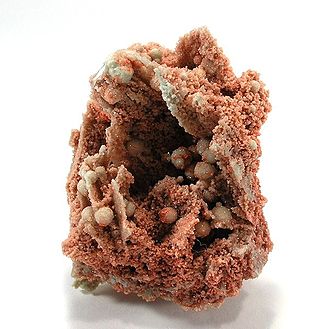
Hilgardite is a borate mineral with the chemical formula Ca2B5O9Cl·H2O. It is transparent and has vitreous luster. It is colorless to light pink with a white streak. It is rated 5 on the Mohs Scale. It crystallizes in the triclinic crystal system. Crystals occur as distorted tabular triangles and are hemimorphic, polytypes exist.
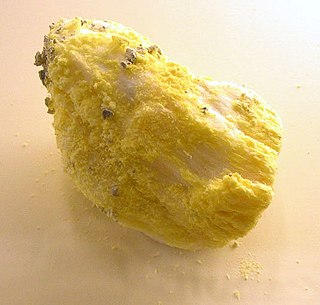
Sassolite is a borate mineral, specifically the mineral form of boric acid. It is usually white to gray, and colourless in transmitted light. It can also take on a yellow colour from sulfur impurities, or brown from iron oxides.

Nahcolite is a soft, colourless or white carbonate mineral with the composition of sodium bicarbonate (NaHCO3) also called thermokalite. It crystallizes in the monoclinic system.
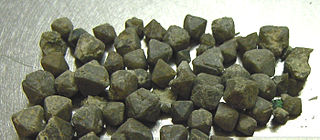
Northupite is an uncommon evaporite mineral, with the chemical formula Na3Mg(CO3)2Cl. It occurs as colourless to dark grey or brown octahedral crystals and as globular masses. In synthetic material it forms a series with tychite (Na6Mg2(CO3)4SO4).

Searlesite is a sodium borosilicate mineral, with the chemical formula NaBSi2O5(OH)2. It was discovered in 1914 at Searles Lake, California, and was named to honor John W. Searles (16 November 1828 - 7 October 1897), California pioneer, who drilled the well that yielded the first known Searlesite.
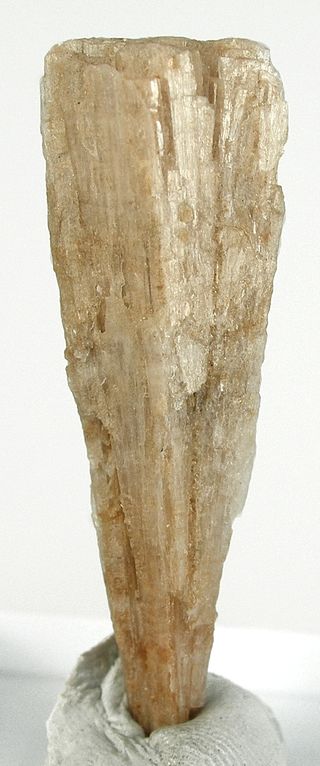
Syngenite is an uncommon potassium calcium sulfate mineral with formula K2Ca(SO4)2·H2O. It forms as prismatic monoclinic crystals and as encrustations.

Piypite is a rare potassium, copper sulfate mineral with formula: K2Cu2O(SO4)2. It crystallizes in the tetragonal system and occurs as needlelike crystals and masses. Individual crystals are square in cross-section and often hollow. It is emerald green to black in color with a vitreous to greasy luster.

Pinnoite is a magnesium borate mineral with formula: MgB2O(OH)6 or MgB2O4·3(H2O). It crystallizes in the tetragonal crystal system and occurs as colorless to yellow or light green radial fibrous clusters and rarely as short prismatic crystals.
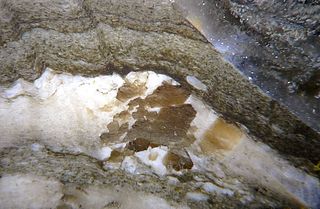
Fontarnauite is a relatively recently described, rare sulfate, borate mineral with the chemical formula (Na,K)2(Sr,Ca)(SO4)[B5O8(OH)]·2H2O. It is found in an evaporite boron deposit. It coexists with other evaporite boron minerals, especially probertite. It is monoclinic, crystallizing in the space group P21/c.
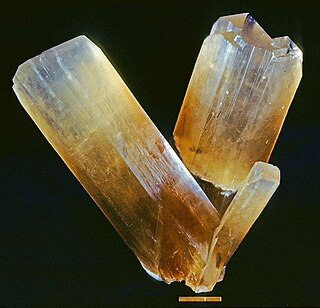
Borax is a borate mineral found in evaporite deposits of alkaline lacustrine environments and as a surface efflorescence in arid regions. It is the chief mineral mined from the deposits at Boron, California and nearby locations, and is the chief source of commercial borax.




















